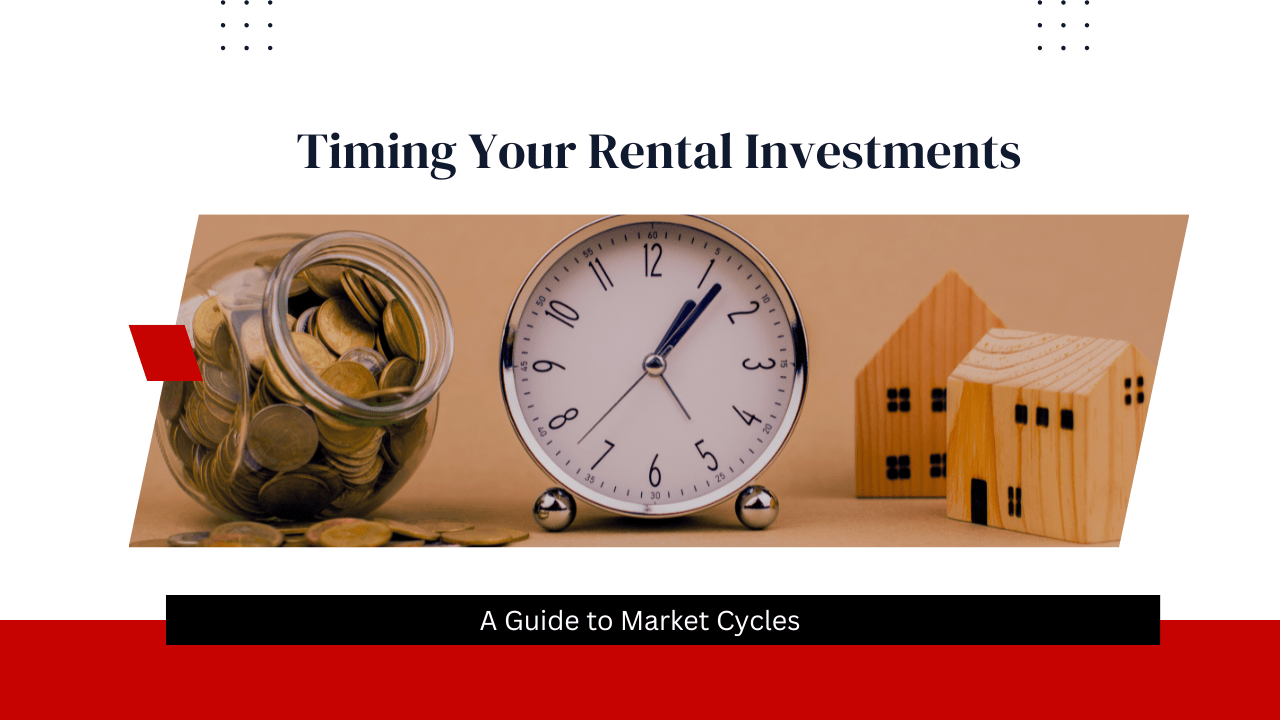If you own rental property or you’re thinking about investing in rental property, you might be wondering what the market is likely to do for the rest of this year.
It’s a valid question.
Market cycles can be a force for good when it comes to investing in real estate, but you have to understand them and know how to best position your property and your portfolio to leverage whatever shifts may be occurring.
Timing can mean the difference between a mediocre return and a game-changing windfall for investors, no matter how small or large your portfolio happens to be. Knowing when to buy, hold, or sell a rental property is often tied to understanding the rhythms of the real estate market.
Market cycles are patterns. They’re not mystical prophecies. We know they’re driven by economics, supply and demand, interest rates, and investor sentiment. But here's the catch: even with perfect timing, no investment is risk-free. Conversely, even in uncertain times, there are ways to make smart, profitable rental investments.
We’re breaking down real estate market cycles, discussing the ideal timing for rental investments, and ultimately showing you why, with the right strategy, it’s always a good time to invest.
Understanding Real Estate Market Cycles
The real estate market, like the economy as a whole, moves in cycles. These cycles are recurring, though not always predictable in duration. Understanding the phases of the cycle helps investors make informed decisions about when to buy, sell, or hold.
Let’s take a look.
1. Recovery Phase
The recovery phase typically shows up after a downturn or recession. The market is still weak, but signs of stabilization begin to appear. Vacancies in most rental markets are going to be high, rents are likely to be stagnant or declining, and construction activity remains minimal.
But beneath the surface, the economy starts to recover. We have job growth returning, consumer confidence improving, and property values beginning to stabilize.
Smart investors often find opportunities to buy during this phase, capitalizing on lower prices and reduced competition. Properties can often be acquired at below-market value. However, it takes vision and patience because there’s risk involved, as the turnaround can take time and may not be immediately obvious.
2. Expansion Phase
Demand for housing rises during an expansion phase. Occupancy rates improve, rents begin to increase, and new construction picks up. The broader economy is strong, with job and population growth driving demand for housing. Financing becomes more available, further fueling the market. This is when most investors will find themselves looking to acquire new properties or add to their portfolios.
As rents rise and vacancies fall, cash flow improves. Appreciation potential is also strong. Many investors ride the expansion wave for long-term growth and stability
3. Hyper Supply Phase
What does the hyper supply market cycle look like? Builders, spurred by high demand and profits, start to overbuild. Supply catches up with and eventually surpasses demand. Vacancy rates begin to rise, and rent growth slows or flattens. Investor enthusiasm may still be high, but the signs of an overheated market become clearer.
Timing is critical in these cycles. Investors should become cautious and focus on defensive strategies such as locking in fixed-rate financing, strengthening tenant relationships, and reducing exposure to speculative deals. Some may choose to sell and realize gains from earlier acquisitions.
4. Recession Phase
The market contracts during a recession phase, sometimes dramatically. Oversupply leads to higher vacancies and falling rents. Property values decline, and financing tightens. Foreclosures rise, and investor confidence plummets.
While risky, this is also a time of opportunity for investors. It’s an especially lucrative time for those with available capital. Distressed assets may be acquired at deep discounts. Cash is king in a recessionary phase, and those who can weather the storm often emerge with high-return properties purchased for pennies on the dollar.
The Challenges of Perfect Timing
The idea of “buy low, sell high” is appealing and often repeated in real estate circles, but in practice, it’s nearly impossible to time the market perfectly. Market cycles are influenced by countless variables; interest rates, inflation, local economic growth, government policy, and even global events like pandemics or wars. While cycles are real, they don’t follow a strict schedule.
Trying to wait for the "perfect" time often leads to analysis paralysis. Many would-be investors sit on the sidelines too long, missing out on years of returns while trying to predict the next downturn or upswing. Instead of trying to time the market precisely, it’s better to understand where we are in the cycle and make decisions that align with your goals, strategy, and risk tolerance.
How to Read Local vs. National Cycles
Another critical consideration: real estate is inherently local. While national trends offer useful context, individual markets can move at different paces. For example, while one city may be in the hyper supply phase due to overbuilding, another may still be in expansion because of growing job opportunities and migration.
Smart investors analyze both macro (national) and micro (local) trends. Pay attention to:
Job growth and employment data in your target market
Population migration trends
Housing starts and permit activity
Vacancy rates and rent growth
Cap rate movements and investor sentiment
Understanding your market's position in the cycle helps determine whether to focus on cash flow, appreciation, or value-add strategies.
It's Always a Good Time to Invest—if You Know What You're Doing
Now, here's the twist: while timing matters, there’s always a way to invest successfully in rental real estate, regardless of where we are in the cycle. The secret lies in your strategy and how well you understand your numbers. Our tips? Right here:
Adapt Your Strategy to the Market Cycle
Each phase of the cycle requires a different approach. In expansion, you might focus on value-add properties where appreciation and rent growth can drive returns. In recession, the play might be buying distressed assets at a discount and holding them long-term. In hyper supply, prioritize stability: focus on tenant retention and protecting cash flow.
The right strategy, matched to the cycle, minimizes risk and maximizes opportunity.
Cash Flow is Always Going to Need Your Attention
Regardless of market conditions, buying for positive cash flow protects your downside. If a property produces income above your expenses, even modestly, you have a buffer against value fluctuations.
Chasing appreciation alone is risky. Market values can drop, but rent (and cash flow) tends to be more stable, especially if your property meets essential housing needs.
Financing Can Make or Break Your Deal
Interest rates play a huge role in real estate returns. In high-rate environments (often seen in recession or early recovery), fixed-rate financing protects against future increases. In low-rate markets (typically expansion), you might leverage more, as your cost of capital is cheaper.
What you want to do is to stress-test your financing. Can the property cash flow if rates rise? Will you be forced to refinance in a downturn? Conservative assumptions lead to better long-term outcomes.
Invest for the Long Term
Real estate rewards patience. While flippers and speculators rely on short-term timing, buy-and-hold investors benefit from compounding returns through rent increases, mortgage pay down, and appreciation. Over a 10- or 20-year period, short-term fluctuations matter far less. If you buy a property that cash flows well, in a growing or stable market, and manage it properly, you’ve already stacked the odds in your favor.
Build a Team and Systems
Great investments don’t happen in isolation. You need a team, starting with a smart property management partnership. Working with experts who understand your goals can help you operate effectively in any market. Good systems allow you to respond quickly to changing conditions, whether it’s adjusting rents, refinancing, or scaling up when opportunity strikes.
Invest with Awareness, Not Anxiety
Market cycles are part of the real estate journey. They aren’t something to fear. Instead, they’re something to understand. They provide a framework for risk management and strategic planning, helping you navigate opportunities and avoid costly missteps.
But don’t let the fear of mistiming the market keep you from getting started. Instead, ask:
Does this property cash flow today?
Do I understand the risks in this market phase?
Am I investing with a strategy that aligns with the current cycle?
Do I have a long-term plan?
If you can answer these confidently, it’s a good time to invest—no matter what the headlines say.
Real estate investing isn't about predicting the future, although that would be an excellent superpower to have. Instead, smart investors are busy preparing for the future. If you understand where the market stands and align your strategy accordingly, you can build wealth in any cycle. Because the best time to invest? It’s when you’re ready. And prepared.
 This is our general advice on managing market cycles, and we’d be happy to share some strategies and thoughts that might be unique to you. Contact us at Doud Realty Services, Inc. We provide expert property management in Norfolk, Portsmouth, Hampton Roads, as well as surrounding areas such as Virginia Beach, Suffolk, Chesapeake, and Newport News.
This is our general advice on managing market cycles, and we’d be happy to share some strategies and thoughts that might be unique to you. Contact us at Doud Realty Services, Inc. We provide expert property management in Norfolk, Portsmouth, Hampton Roads, as well as surrounding areas such as Virginia Beach, Suffolk, Chesapeake, and Newport News.


